BAO2202 - Historical Cost Accounting Limitations: Semester 2
VerifiedAdded on 2023/06/07
|5
|1034
|228
Essay
AI Summary
This essay critically examines the limitations of the historical cost accounting method, a conventional approach where transactions are recorded at their original costs. The essay highlights several drawbacks, including its failure to account for price changes due to inflation or technological advancements, leading to unrealistic valuations of fixed assets and inadequate depreciation provisions. It argues that historical cost accounting can distort profitability by not reflecting current market values, potentially mixing capital gains with operating profits. The essay also points out that the method's inability to fairly represent financial positions can lead to incorrect decision-making by users of financial statements. Ultimately, the essay concludes that these limitations diminish the relevance of historical costing for accurately measuring assets, liabilities, and other financial statement items.
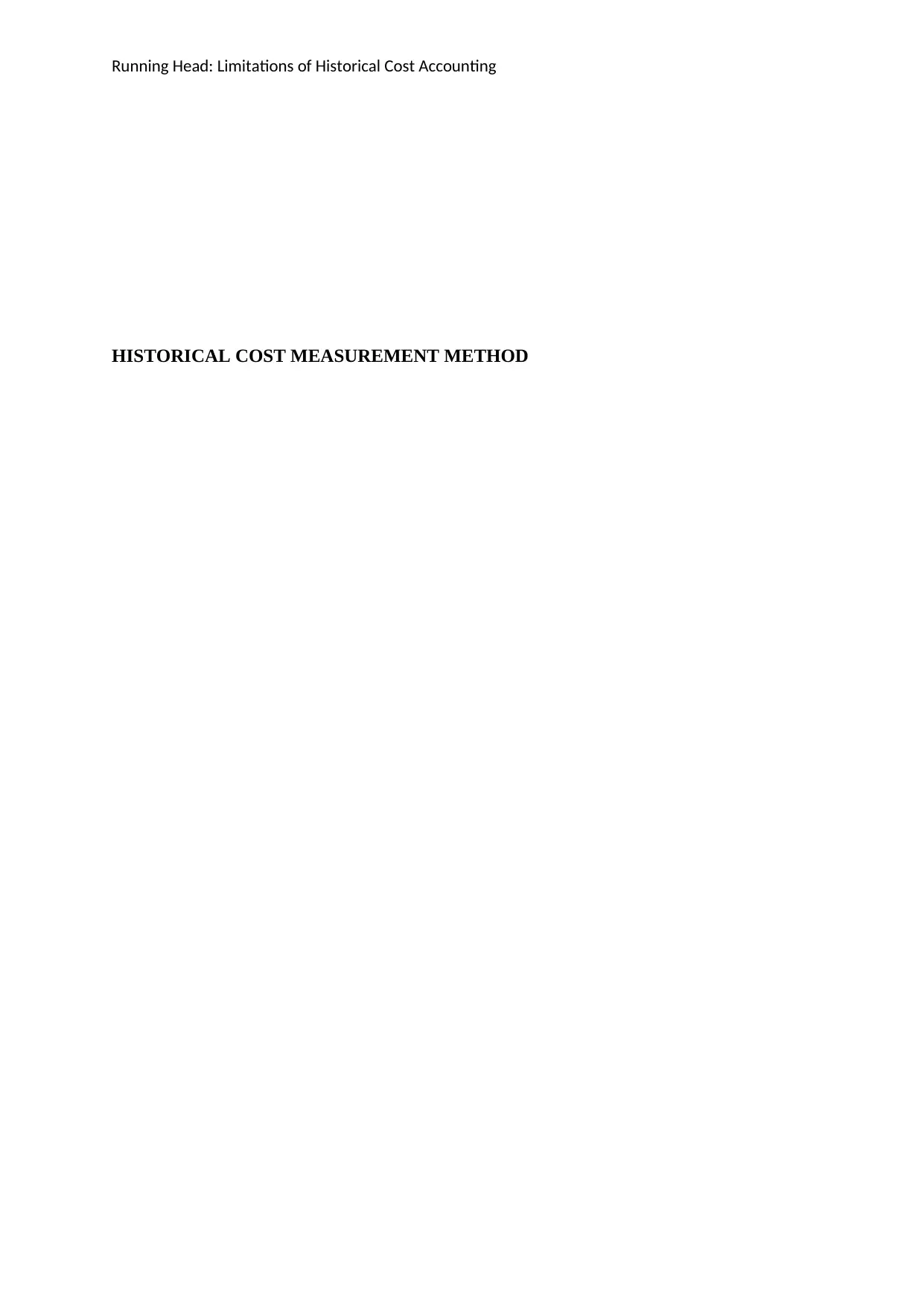
Running Head: Limitations of Historical Cost Accounting
HISTORICAL COST MEASUREMENT METHOD
HISTORICAL COST MEASUREMENT METHOD
Paraphrase This Document
Need a fresh take? Get an instant paraphrase of this document with our AI Paraphraser
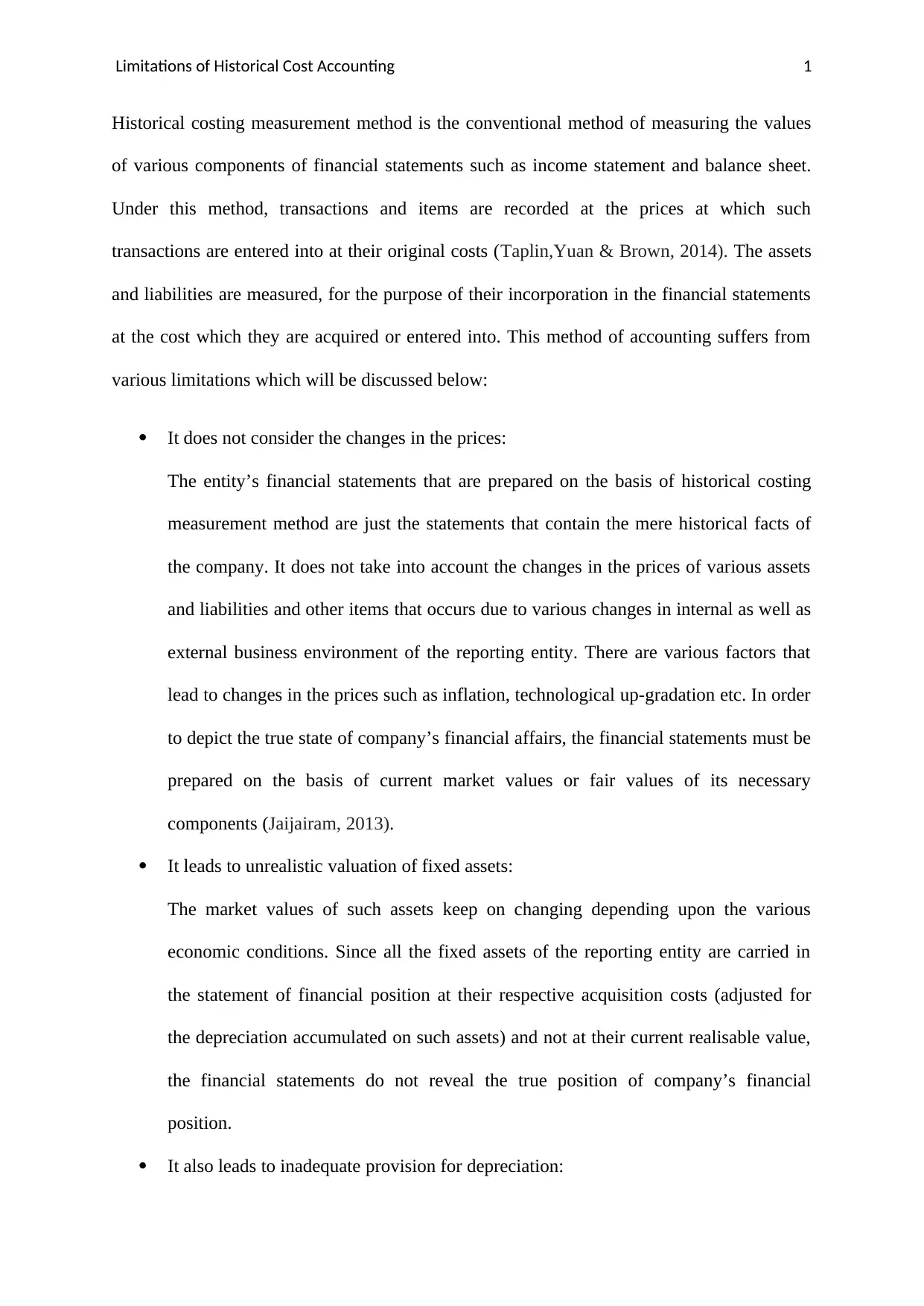
Limitations of Historical Cost Accounting 1
Historical costing measurement method is the conventional method of measuring the values
of various components of financial statements such as income statement and balance sheet.
Under this method, transactions and items are recorded at the prices at which such
transactions are entered into at their original costs (Taplin,Yuan & Brown, 2014). The assets
and liabilities are measured, for the purpose of their incorporation in the financial statements
at the cost which they are acquired or entered into. This method of accounting suffers from
various limitations which will be discussed below:
It does not consider the changes in the prices:
The entity’s financial statements that are prepared on the basis of historical costing
measurement method are just the statements that contain the mere historical facts of
the company. It does not take into account the changes in the prices of various assets
and liabilities and other items that occurs due to various changes in internal as well as
external business environment of the reporting entity. There are various factors that
lead to changes in the prices such as inflation, technological up-gradation etc. In order
to depict the true state of company’s financial affairs, the financial statements must be
prepared on the basis of current market values or fair values of its necessary
components (Jaijairam, 2013).
It leads to unrealistic valuation of fixed assets:
The market values of such assets keep on changing depending upon the various
economic conditions. Since all the fixed assets of the reporting entity are carried in
the statement of financial position at their respective acquisition costs (adjusted for
the depreciation accumulated on such assets) and not at their current realisable value,
the financial statements do not reveal the true position of company’s financial
position.
It also leads to inadequate provision for depreciation:
Historical costing measurement method is the conventional method of measuring the values
of various components of financial statements such as income statement and balance sheet.
Under this method, transactions and items are recorded at the prices at which such
transactions are entered into at their original costs (Taplin,Yuan & Brown, 2014). The assets
and liabilities are measured, for the purpose of their incorporation in the financial statements
at the cost which they are acquired or entered into. This method of accounting suffers from
various limitations which will be discussed below:
It does not consider the changes in the prices:
The entity’s financial statements that are prepared on the basis of historical costing
measurement method are just the statements that contain the mere historical facts of
the company. It does not take into account the changes in the prices of various assets
and liabilities and other items that occurs due to various changes in internal as well as
external business environment of the reporting entity. There are various factors that
lead to changes in the prices such as inflation, technological up-gradation etc. In order
to depict the true state of company’s financial affairs, the financial statements must be
prepared on the basis of current market values or fair values of its necessary
components (Jaijairam, 2013).
It leads to unrealistic valuation of fixed assets:
The market values of such assets keep on changing depending upon the various
economic conditions. Since all the fixed assets of the reporting entity are carried in
the statement of financial position at their respective acquisition costs (adjusted for
the depreciation accumulated on such assets) and not at their current realisable value,
the financial statements do not reveal the true position of company’s financial
position.
It also leads to inadequate provision for depreciation:
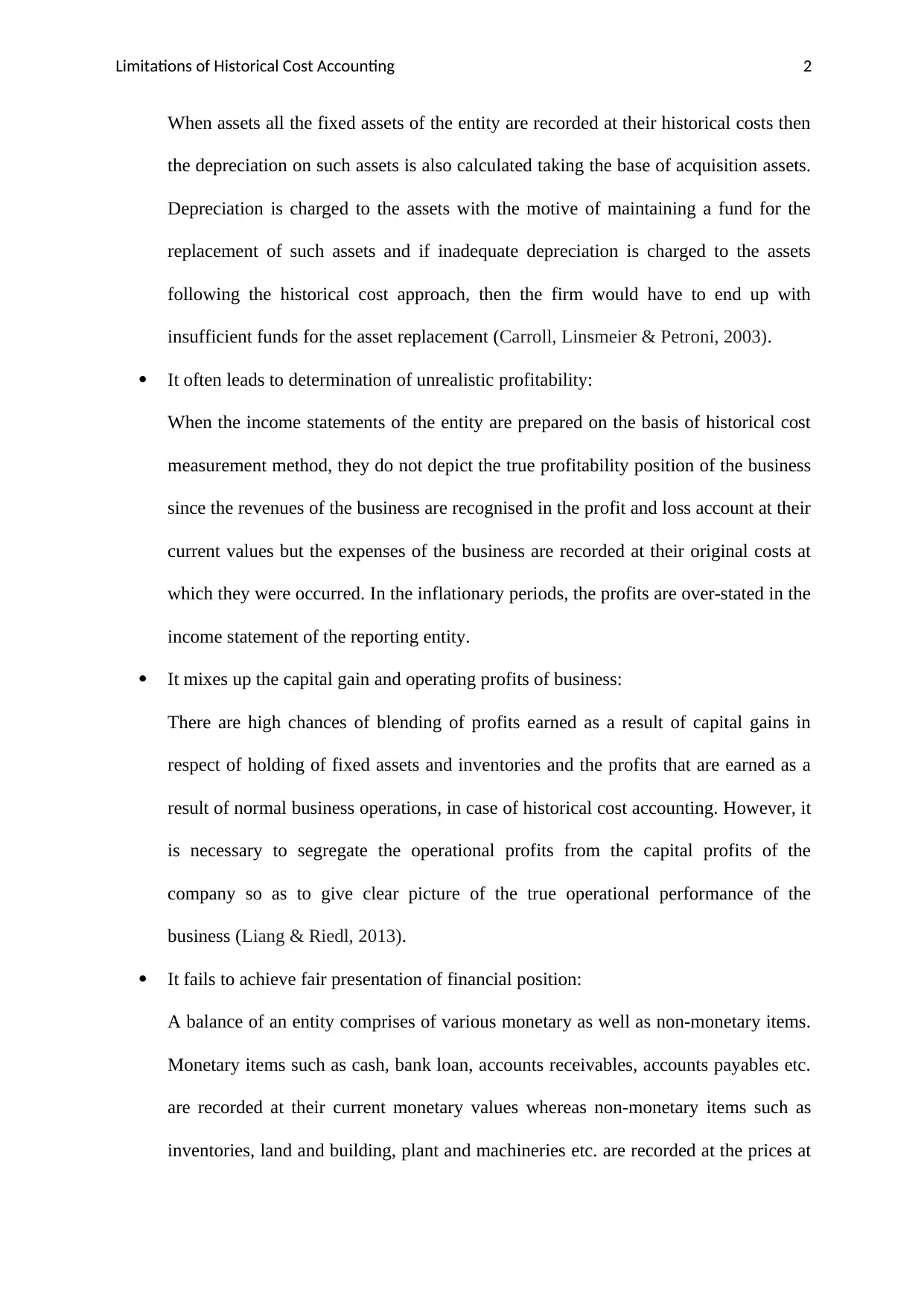
Limitations of Historical Cost Accounting 2
When assets all the fixed assets of the entity are recorded at their historical costs then
the depreciation on such assets is also calculated taking the base of acquisition assets.
Depreciation is charged to the assets with the motive of maintaining a fund for the
replacement of such assets and if inadequate depreciation is charged to the assets
following the historical cost approach, then the firm would have to end up with
insufficient funds for the asset replacement (Carroll, Linsmeier & Petroni, 2003).
It often leads to determination of unrealistic profitability:
When the income statements of the entity are prepared on the basis of historical cost
measurement method, they do not depict the true profitability position of the business
since the revenues of the business are recognised in the profit and loss account at their
current values but the expenses of the business are recorded at their original costs at
which they were occurred. In the inflationary periods, the profits are over-stated in the
income statement of the reporting entity.
It mixes up the capital gain and operating profits of business:
There are high chances of blending of profits earned as a result of capital gains in
respect of holding of fixed assets and inventories and the profits that are earned as a
result of normal business operations, in case of historical cost accounting. However, it
is necessary to segregate the operational profits from the capital profits of the
company so as to give clear picture of the true operational performance of the
business (Liang & Riedl, 2013).
It fails to achieve fair presentation of financial position:
A balance of an entity comprises of various monetary as well as non-monetary items.
Monetary items such as cash, bank loan, accounts receivables, accounts payables etc.
are recorded at their current monetary values whereas non-monetary items such as
inventories, land and building, plant and machineries etc. are recorded at the prices at
When assets all the fixed assets of the entity are recorded at their historical costs then
the depreciation on such assets is also calculated taking the base of acquisition assets.
Depreciation is charged to the assets with the motive of maintaining a fund for the
replacement of such assets and if inadequate depreciation is charged to the assets
following the historical cost approach, then the firm would have to end up with
insufficient funds for the asset replacement (Carroll, Linsmeier & Petroni, 2003).
It often leads to determination of unrealistic profitability:
When the income statements of the entity are prepared on the basis of historical cost
measurement method, they do not depict the true profitability position of the business
since the revenues of the business are recognised in the profit and loss account at their
current values but the expenses of the business are recorded at their original costs at
which they were occurred. In the inflationary periods, the profits are over-stated in the
income statement of the reporting entity.
It mixes up the capital gain and operating profits of business:
There are high chances of blending of profits earned as a result of capital gains in
respect of holding of fixed assets and inventories and the profits that are earned as a
result of normal business operations, in case of historical cost accounting. However, it
is necessary to segregate the operational profits from the capital profits of the
company so as to give clear picture of the true operational performance of the
business (Liang & Riedl, 2013).
It fails to achieve fair presentation of financial position:
A balance of an entity comprises of various monetary as well as non-monetary items.
Monetary items such as cash, bank loan, accounts receivables, accounts payables etc.
are recorded at their current monetary values whereas non-monetary items such as
inventories, land and building, plant and machineries etc. are recorded at the prices at
⊘ This is a preview!⊘
Do you want full access?
Subscribe today to unlock all pages.

Trusted by 1+ million students worldwide
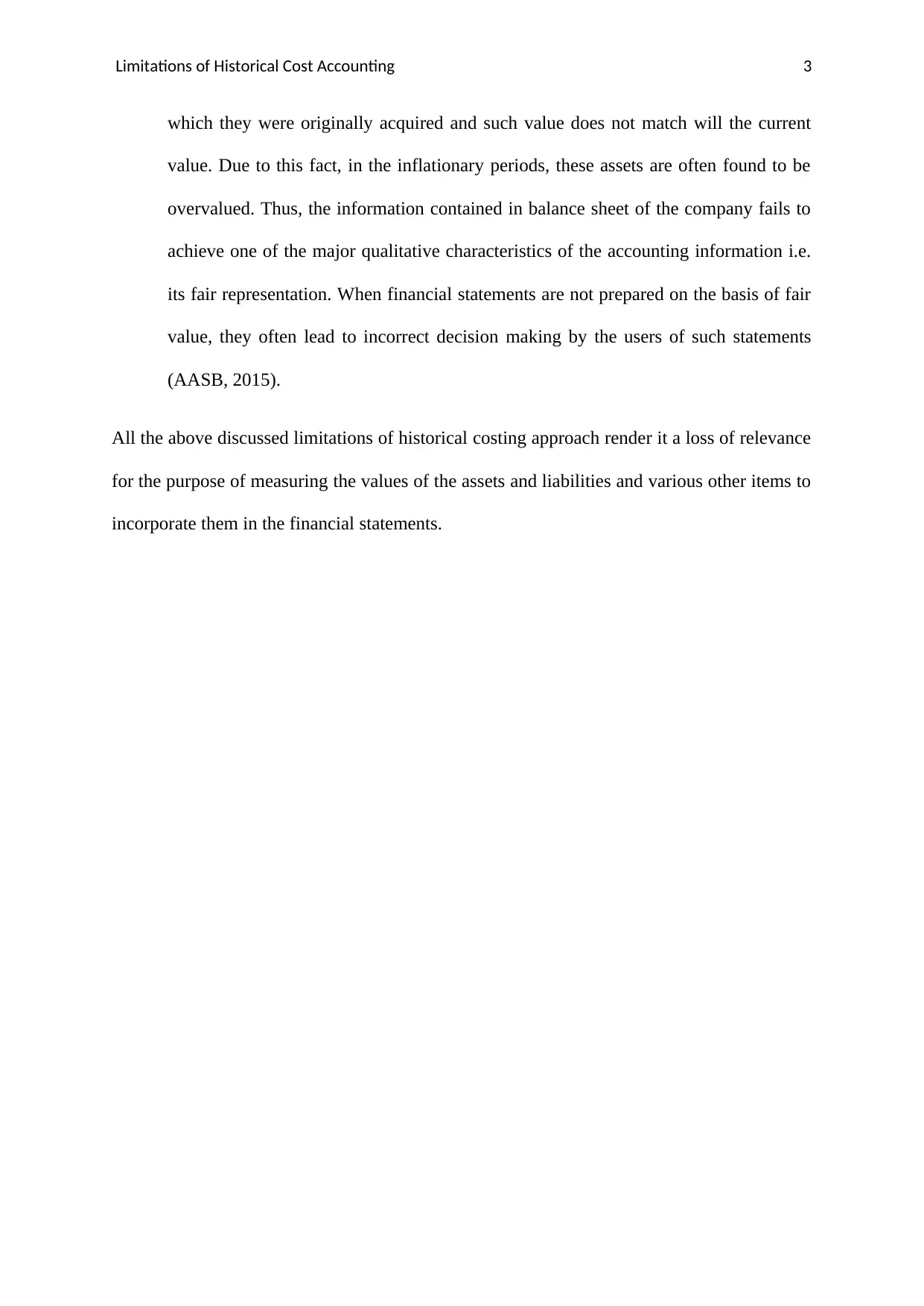
Limitations of Historical Cost Accounting 3
which they were originally acquired and such value does not match will the current
value. Due to this fact, in the inflationary periods, these assets are often found to be
overvalued. Thus, the information contained in balance sheet of the company fails to
achieve one of the major qualitative characteristics of the accounting information i.e.
its fair representation. When financial statements are not prepared on the basis of fair
value, they often lead to incorrect decision making by the users of such statements
(AASB, 2015).
All the above discussed limitations of historical costing approach render it a loss of relevance
for the purpose of measuring the values of the assets and liabilities and various other items to
incorporate them in the financial statements.
which they were originally acquired and such value does not match will the current
value. Due to this fact, in the inflationary periods, these assets are often found to be
overvalued. Thus, the information contained in balance sheet of the company fails to
achieve one of the major qualitative characteristics of the accounting information i.e.
its fair representation. When financial statements are not prepared on the basis of fair
value, they often lead to incorrect decision making by the users of such statements
(AASB, 2015).
All the above discussed limitations of historical costing approach render it a loss of relevance
for the purpose of measuring the values of the assets and liabilities and various other items to
incorporate them in the financial statements.
Paraphrase This Document
Need a fresh take? Get an instant paraphrase of this document with our AI Paraphraser
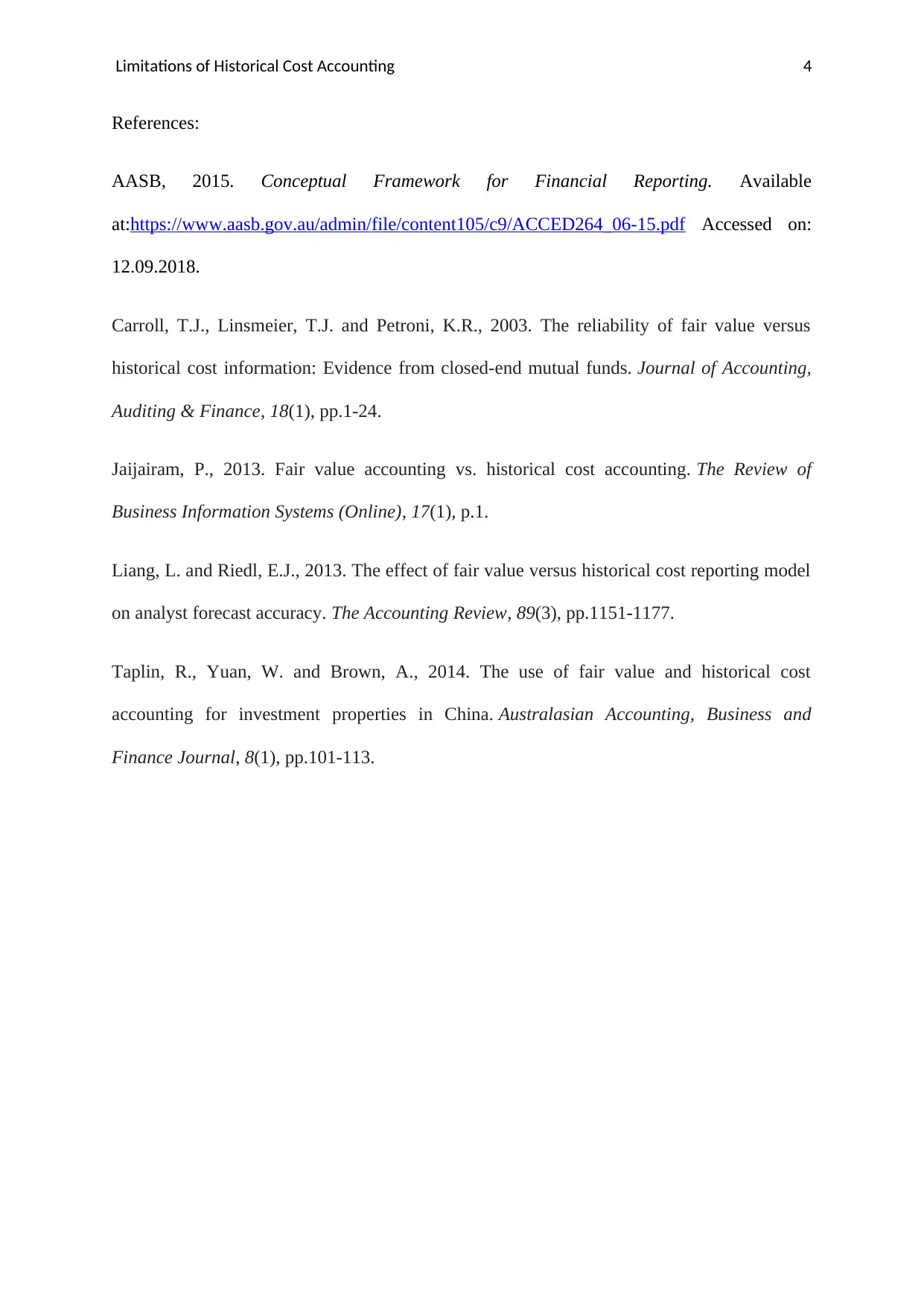
Limitations of Historical Cost Accounting 4
References:
AASB, 2015. Conceptual Framework for Financial Reporting. Available
at:https://www.aasb.gov.au/admin/file/content105/c9/ACCED264_06-15.pdf Accessed on:
12.09.2018.
Carroll, T.J., Linsmeier, T.J. and Petroni, K.R., 2003. The reliability of fair value versus
historical cost information: Evidence from closed-end mutual funds. Journal of Accounting,
Auditing & Finance, 18(1), pp.1-24.
Jaijairam, P., 2013. Fair value accounting vs. historical cost accounting. The Review of
Business Information Systems (Online), 17(1), p.1.
Liang, L. and Riedl, E.J., 2013. The effect of fair value versus historical cost reporting model
on analyst forecast accuracy. The Accounting Review, 89(3), pp.1151-1177.
Taplin, R., Yuan, W. and Brown, A., 2014. The use of fair value and historical cost
accounting for investment properties in China. Australasian Accounting, Business and
Finance Journal, 8(1), pp.101-113.
References:
AASB, 2015. Conceptual Framework for Financial Reporting. Available
at:https://www.aasb.gov.au/admin/file/content105/c9/ACCED264_06-15.pdf Accessed on:
12.09.2018.
Carroll, T.J., Linsmeier, T.J. and Petroni, K.R., 2003. The reliability of fair value versus
historical cost information: Evidence from closed-end mutual funds. Journal of Accounting,
Auditing & Finance, 18(1), pp.1-24.
Jaijairam, P., 2013. Fair value accounting vs. historical cost accounting. The Review of
Business Information Systems (Online), 17(1), p.1.
Liang, L. and Riedl, E.J., 2013. The effect of fair value versus historical cost reporting model
on analyst forecast accuracy. The Accounting Review, 89(3), pp.1151-1177.
Taplin, R., Yuan, W. and Brown, A., 2014. The use of fair value and historical cost
accounting for investment properties in China. Australasian Accounting, Business and
Finance Journal, 8(1), pp.101-113.
1 out of 5
Related Documents
Your All-in-One AI-Powered Toolkit for Academic Success.
+13062052269
info@desklib.com
Available 24*7 on WhatsApp / Email
![[object Object]](/_next/static/media/star-bottom.7253800d.svg)
Unlock your academic potential
Copyright © 2020–2025 A2Z Services. All Rights Reserved. Developed and managed by ZUCOL.





